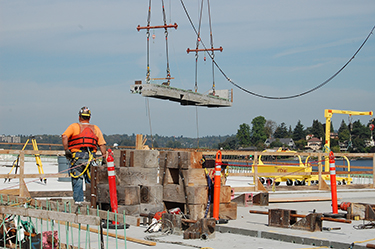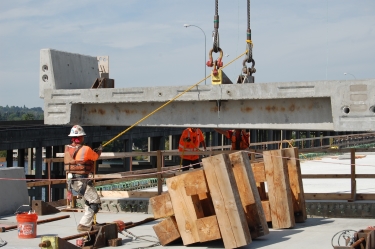|
Subscribe / Renew |
|
|
Contact Us |
|
| ► Subscribe to our Free Weekly Newsletter | |
| home | Welcome, sign in or click here to subscribe. | login |
Construction
| |
August 25, 2015
Last panel in on 520's low-rise deck
Crews have finished installing 776 interlocking precast concrete panels that make up the low-rise deck for the new state Route 520 floating bridge.
Yesterday the last panel — 7.5 feet wide, and weighing 100 tons — was lowered by a barge-mounted derrick crane and guided into place with a few nudges and rope pulls by workers on adjoining decks.
The final panel is about half the width of the other low-rise deck panels. All are post-tensioned with 5 million pounds of force.
Greg Meadows, construction manager for WSDOT, called it a key milestone for the bridge. The next milestone is finishing 27 cast-in-place deck spans for the two high-rise ends of the bridge over Lake Washington.
More work remains including installation of traffic barriers, noise walls, lighting, sign bridges, pedestrian railings, and placing more than 70,000 tons of rock ballast inside the pontoons.
Meadows said crews have used a match-cast system for the low-rise decks: pouring one section and using one of its sides as the form for the next panel. “It's like a Lego jigsaw puzzle,” he said.
All the deck panels were made in Kenmore and barged to the site. Pontoons were made in Aberdeen and Tacoma.
The floating section of the bridge is made of 21 longitudinal pontoons and two cross pontoons. Each pontoon supports about 50 roadway panels. The roadway is raised at least 12 feet off the pontoons by 771 columns that support 331 girders below the deck spans.
The space between the pontoons and deck allows easier access for maintenance crews and keeps waves from splashing onto commuters during storms.
Longitudinal pontoons are 360 feet long and weigh 11,000 tons each. They are kept in place by 58 anchors, some weighing 450 tons. Additional support is provided by 54 smaller supplemental pontoons.
Each pontoon has a leak detector that is connected to some of the 300 miles of electrical wiring running through the bridge.
Kiewit/General/Manson is the joint venture team for the bridge.
Meadows said the new bridge is on track to open in late April 2016.
The new bridge will add an HOV lane in either direction, shoulders for stalled cars, and a 14-foot pedestrian/bike path. It is 132 feet longer than the existing bridge, which for 52 years has been the world's longest floating highway.
The Legislature recently passed a transportation measure that authorized $1.64 billion to finish the project, including stronger Portage Bay and Union Bay bridges; highway lids in the Montlake and Roanoke neighborhoods; and a second bascule bridge across the Montlake Cut.
Meadows said the old bridge will eventually be decommissioned and taken off the lake with barges. Its fate is up to Kiewit/General/Manson.




